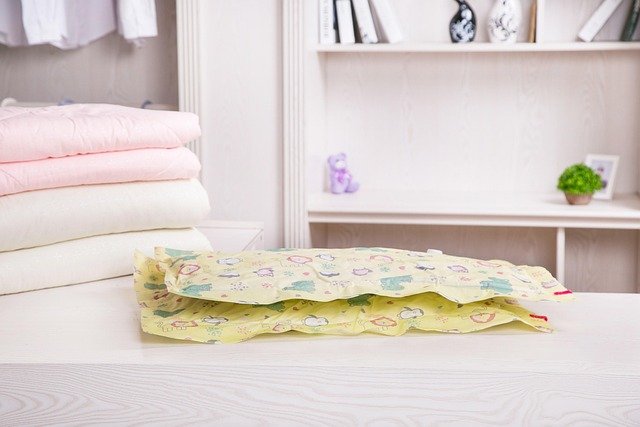Maintenance and Reuse: Extending the Life of Stored Household Textiles
Storing household textiles effectively helps protect fabrics, free up closet space, and simplify seasonal rotation. Proper use and regular maintenance of compressed, airtight storage systems can preserve bedding, garments, and linens while reducing wear. This primer explains practical care, reuse practices, and organization tips to keep textiles in good condition over time.

How does compression extend storage space?
Compression reduces the bulk of soft items by removing excess air, making it easier to fit bedding, blankets, and bulky garments into limited closet or storage areas. When textiles are compressed properly, you gain measurable space for other items and can declutter living areas without sacrificing access to seasonal pieces. Use gentle compression: over-compressing delicate fabrics repeatedly can stress seams and fibers, so balance space savings with long-term fabric health.
Smaller items like sweaters and towels respond best to moderate compression. Heavier or structured garments should be stored with minimal compression or folded separately to maintain shape.
Why airtight seals matter for protection and preservation
An airtight seal protects stored textiles from dust, pests, and humidity, reducing the risk of mildew and pest damage. For preservation, keep storage conditions stable: avoid direct sunlight, damp basements, and attics that experience wide temperature swings. Airtight systems create a barrier that limits exposure to airborne contaminants and bacteria, but remember that fabrics should be completely clean and dry before sealing to prevent trapped stains or odors from setting in.
Check seals periodically; a failing valve or zipper can allow air back in and negate protection benefits.
Tips for organizing textiles and bedding for seasons
Organizing by season simplifies rotation and helps you find items without rummaging through everything. Label containers with contents and the season, and place frequently used items toward the front of a closet. For bedding and bulk blankets, compress only when necessary and store heavier items at the bottom of stacks to avoid crushing finer fabrics.
Consider grouping by function (sleeping, guest, outdoor) and using clear storage or consistent labeling to streamline retrieval during seasonal changes.
Caring for garments in closet rotations and travel packing
Before storage or packing for travel, launder garments according to care labels and fully dry them. Natural fibers like wool and down need special attention: clean according to instructions and avoid long-term compression for items that rely on loft, such as down jackets or thick duvets. For garments in rotating wardrobes, use breathable garment bags for short-term storage and reserve airtight compression only for longer-term seasonal storage.
When packing for travel, compression can save space but inspect items on arrival and refold promptly to reduce wrinkles and stress on seams.
Packing strategies: declutter, protection, and organization
Declutter before packing: donate or mend items you no longer wear to limit the quantity you store. For the items you keep, use folding techniques that minimize creasing, and place fragile or embellished garments in protective layers to prevent abrasion. Pack items by category—bedding with bedding, garments with garments—to maintain organization and reduce repeated handling.
Avoid storing dirty or chemically treated clothes; contaminants can migrate and damage other textiles over time. Rotate stored items annually to inspect condition and address any emerging issues.
Maintenance and reuse: cleaning, inspection, and longevity
Routine maintenance extends textile life. Inspect stored items every few months for signs of moisture, pests, or fabric stress. Gently air items if they have been sealed for long periods, and rewash pieces that develop odors before resealing. For reusable storage systems, clean seals and valves according to manufacturer guidelines to maintain airtight performance and prevent mold buildup on plastics or fabric liners.
Reusing storage solutions responsibly reduces waste and cost. Replace any components that show damage—small tears, compromised seals, or faulty closures—to preserve protection. Take care when reusing compressed items: give natural fibers time to recover loft after long storage periods before using them regularly.
Maintenance across seasons and long-term preservation
Seasonal transitions are a good prompt for a full maintenance cycle: launder, repair, declutter, and reseal. For long-term preservation, consider acid-free tissue between delicate layers, silica packets to control humidity, and climate-stable storage areas. Avoid extreme temperature or humidity fluctuations; consistent conditions are better for avoiding fabric degradation.
Document care steps and keep an inventory to reduce repeated handling. Thoughtful maintenance practices help textiles remain usable and attractive through many seasons, supporting both sustainability and home organization.
Conclusion
Extending the life of stored household textiles combines practical storage choices with ongoing care. Using compression and airtight methods thoughtfully increases space and protection, while organized packing and regular maintenance prevent damage. By cleaning items before storage, inspecting seals, and rotating or airing textiles seasonally, you can preserve bedding, garments, and linens for longer use without sacrificing accessibility or quality.





